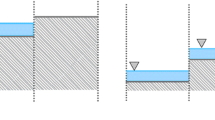Abstract
In this paper, we focus on the efficient implementation of path conservative Roe type high order finite volume schemes to simulate shallow flows. The motion of a layer of homogeneous non-viscous fluid is supposed to be governed by the shallow-water system, formulated under the form of a conservation law with source terms. The implementation of the scheme is carried out on Graphics Processing Units (GPUs), thus achieving a substantial improvement of the speedup with respect to normal CPUs. Finally, some numerical experiments are presented.
Similar content being viewed by others
References
M.J. Castro, J.A. García, J.M. González and C. Parés (2006). A parallel 2d finite volume scheme for solving systems of balance laws with non-conservative products: application to shallow flows. Comp. Meth. Appl. Mech. Eng. 196, 2788–2815.
M.J. Castro, J.A. García, J.M. González and C. Parés (2008). Solving shallow-water systems in 2D domains using finite volume methods and multimedia SSE instructions. J. Comput. App. Math., 221: 16–32.
M.J. Castro, E.D. Fernández, A.M. Ferreiro, A. García, C. Parés (2009). High order extension of Roe schemes for two dimensional nonconservative hyperbolic systems. J. Sci. Comput. 39, 67–114.
G. Dal Maso, P.G. LeFloch and F. Murat (1995). Definition and weak stability of nonconservative products. J. Math. Pures Appl. 74: 483–548.
J.M. Gallardo, S. Ortega, M. de la Asunción, J.M. Mantas (2010). Two-dimensional compact third-order polynomial reconstructions. Solving nonconservative hyperbolic systems using GPUs. Submitted to J. Sci. Comput.
T.R. Hagen, J.M. Hjelmervik, K.A. Lie, J.R. Natvig, M. Ofstad (2005). Visual simulation of shallow-water waves. Sim. Modelling Pract. and Th. 13, 716–726.
A. Harten, J.M. Hyman (1983). Self-adjusting grid methods for one-dimensional hyperbolic conservation laws. J. Comp. Phys. 50, 235–269.
M. Lastra, J.M. Mantas, C. Ureña, M.J. Castro, J.A. García (2009). Simulation of shallow-water systems using graphics processing units. Math. Comp. Simul. 80, 598–618.
M. de la Asunción, J.M. Mantas, M.J. Castro (2009). Simulation of one-layer shallow water systems on multicore and CUDA architectures. Accepted in J. Supercomputing.
P.G. LeFloch. Shock waves for nonlinear hyperbolic systems in nonconservative form (1989). Institute for Math. and its Appl., Minneapolis, Preprint 593.
S. Noelle, N. Pankratz, G. Puppo, J. Natvig (2006). Well-balanced finite volume schemes of arbitrary order of accuracy for shallow water flows. J. Comput. Phys. 213, 474–499.
NVIDIA. CUDA Zone. http://www.nvidia.com/object/cuda_home.html. Accessed November 2009.
C. Parés (2006). Numerical methods for nonconservative hyperbolic systems: a theoretical framework. SIAM J. Num. Anal. 44, 300–321.
Chapman B, Jost G, van der Pas R (2007). Using OpenMP: Portable Shared Memory Parallel Programming, The MIT Press.
J.D. Owens, D. Luebke, N. Govindaraju, M. Harris, J. Krüger, A.E. Lefohn, T. Purcell (2005). A Survey of General-Purpose Computation on Graphics Hardware, Eurographics 2005 State of the Art Report.
J.D. Owens, M. Houston, D. Luebke, S. Green, J.E. Stone, J.C. Phillips (2008). GPU Computing. Proceedings of the IEEE, 96(5): 879–899.
M. Rumpf, R. Strzodka (2006). Graphics Processor Units: New Prospects for Parallel Computing, L. N. in Computational Science and Engineering 51, 89–121.
C.-W. Shu, S. Osher (1998). Efficient implementation of essentially non-oscillatory shock capturing schemes. J. Comput. Phys. 77, 439–71.
A.I. Volpert (1967). Spaces BV and quasilinear equations, Math. USSR Sbornik, 73 (1967): 255–302.
G. Walz (1997). Romberg Type Cubature over Arbitrary Triangles. Mannheimer Mathem. Manuskripte Nr.225, Mannhein.
Author information
Authors and Affiliations
Corresponding author
Additional information
This research has been partially supported by the Spanish Government Research projects MTM09-11923, TIN2007-29664-E, MTM2008-06349-C03-03, and P06-RNM-01594. The numerical computations have been performed at the Laboratory of Numerical Methods of the University of Málaga.
Rights and permissions
About this article
Cite this article
Castro, M.J., Ortega, S., de la Asunción, M. et al. On the benefits of using GPUS to simulate shallow flows with finite volume schemes. SeMA 50, 27–44 (2010). https://doi.org/10.1007/BF03322540
Published:
Issue Date:
DOI: https://doi.org/10.1007/BF03322540




